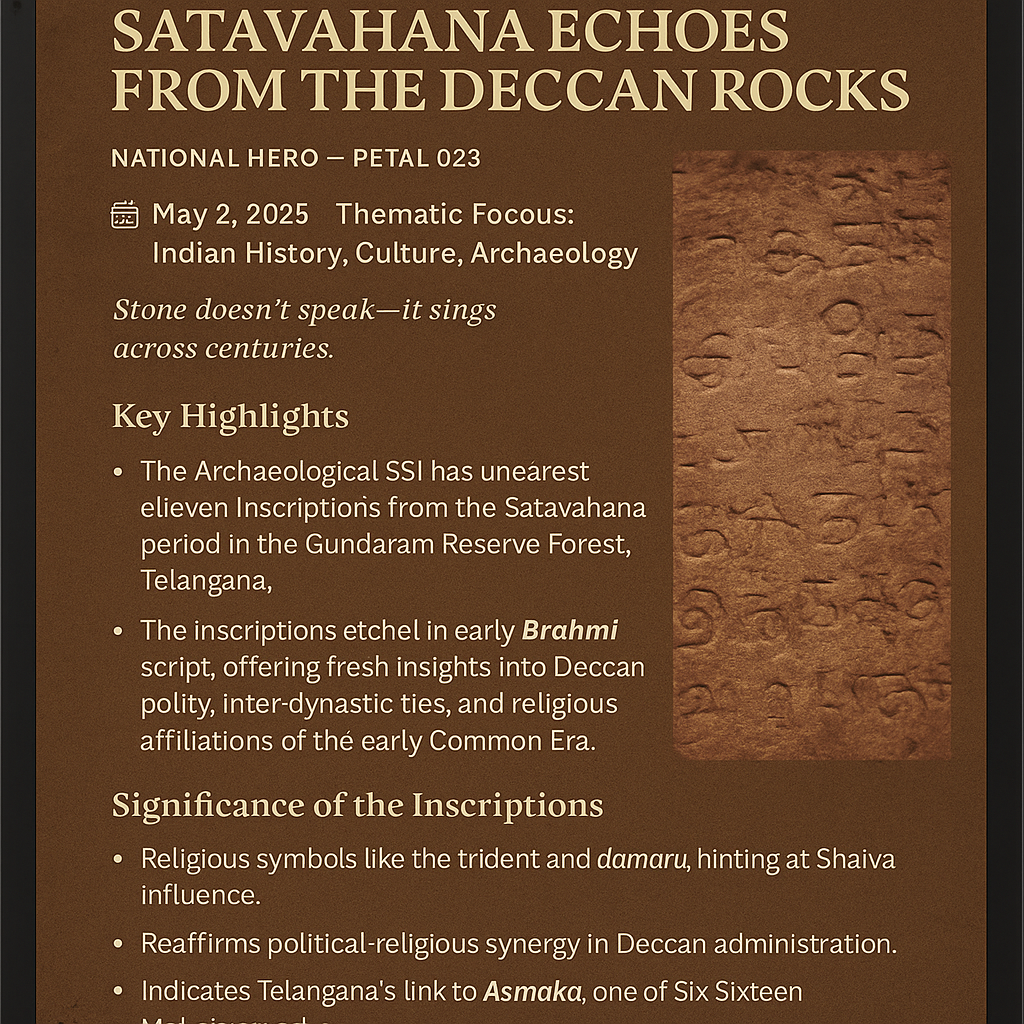
📅 May 2, 2025, Post 2: 🪷 Satavahana Echoes from the Deccan Rocks |Mains Essay Attached | Target IAS-26 MCQs Attached: A complete Package!
🪷 Satavahana Echoes from the Deccan Rocks

NATIONAL HERO
📅 May 2, 2025
Thematic Focus: Indian History, Culture, Archaeology, GS I
🌿 Opening Whisper
Stone doesn’t speak — it sings across centuries.
🔍 Key Highlights
• The Archaeological Survey of India (ASI) has unearthed eleven inscriptions from the Satavahana period in the Gundaram Reserve Forest, Telangana.
• The inscriptions, etched in early Brahmi script, offer fresh insights into Deccan polity, inter-dynastic ties, and religious affiliations of the early Common Era.
• A key inscription referencing the Hāritiputra lineage implies a strong alliance between the Chutu dynasty and the Satavahanas.
🏛️ Legacy of the Satavahanas
- Founded by Simuka in the post-Mauryan period (~1st century BCE).
- Territorial base: Present-day Andhra Pradesh, Telangana, Maharashtra.
- Capitals: Pratishthana (Paithan), Amaravati.
🧱 Notable Rulers:
• Simuka – Supported Jain & Buddhist architecture.
• Satakarni I – Performed Ashvamedha Yajna, conquered Kalinga.
• Hala – Authored Gatha Saptashati (700 love poems in Prakrit).
• Gautamiputra Satakarni – Expanded empire, defeated Shakas, known as Ekabrahmana.
• Yajna Sri Satakarni – Encouraged maritime trade, coins feature ships.
🛡️ Governance:
• Senapati (Military Governors) – Managed both military and civil affairs.
• Feudatory system with ranks: Raja, Mahabhoja, and Senapati.
• Land grants made to Brahmins & Buddhist monks for religious/educational purposes.
📜 Significance of the Inscriptions
- Mention religious symbols like the trident and damaru, hinting at Shaiva influence.
- Reaffirm political-religious synergy in Deccan administration.
- Indicate Telangana’s link to Asmaka, one of the Sixteen Mahajanapadas.
- Highlight the cultural depth and inter-dynastic diplomacy of early Deccan.
📘 GS Paper Mapping
Prelims:
• Satavahana Dynasty
• Early Brahmi Script
• Sixteen Mahajanapadas
• ASI Findings in Telangana
Mains:
• GS I – Indian culture and ancient Indian history
• GS I – Role of archaeology in understanding ancient polity
• GS I – Cultural syncretism in Deccan history
🔮 A Thought Spark — by IAS Monk
When kingdoms perish, it is the language of stone that bears witness — chiseled with memory, shaded by time.
High Quality Mains Essay For Practice :
Word Limit 1000-1200
Stone Doesn’t Speak—It Sings Across Centuries: The Political and Cultural Legacy of the Satavahanas
In the quiet canopy of Telangana’s Gundaram Reserve Forest, a voice once thought silent has begun to sing again. The recent discovery of eleven Satavahana-era inscriptions by the Archaeological Survey of India (ASI) is not merely a historical footnote. It is a powerful echo of a civilization that shaped the political, cultural, and economic contours of early India. When we read stone, we do not just read facts — we feel the pulse of a people, their gods, their wars, their poetry, and their vision of order.
The Satavahana dynasty, often overshadowed in popular memory by the Mauryas or Guptas, was a keystone in the post-Mauryan transition. It filled the power vacuum in the Deccan, stitched together diverse regions, and balanced local autonomy with imperial vision — a model that speaks to India’s diversity even today.
A Dynasty of Cultural Synthesis
The term Satavahana in Prakrit — “driven by seven” — is said to symbolize the chariot of the Sun God. It is apt, for the dynasty carried forward the light of Indian civilization into the southern and western frontiers. Founded by Simuka around the 1st century BCE, the Satavahanas ruled over a wide territory comprising modern-day Andhra Pradesh, Telangana, Maharashtra, and parts of Karnataka and Madhya Pradesh.
Far from being a monolithic power, the Satavahanas embodied cultural pluralism. Their architecture, inscriptions, coins, and literature bear witness to religious tolerance, patronage of Buddhism and Brahmanism, and a deep engagement with Prakrit literary culture. The famous ruler Hāla, for instance, was not just a monarch but also a poet — authoring the Gāthā Saptashati, a lyrical collection of 700 love poems in Prakrit. This confluence of statecraft and aesthetic sensibility is rare in history and defines the unique legacy of this dynasty.
Decoding the Inscriptions: Power in Stone
The early Brahmi inscriptions discovered in Telangana offer first-hand evidence of how Satavahana rule operated on the ground. More than administrative records, these inscriptions are political messages — declarations of lineage, legitimacy, and cultural worldview.
One inscription, referencing the Hāritiputra lineage, hints at diplomatic alliances with the Chutu dynasty, showcasing the Satavahanas’ strategy of balancing power through marriage, mutual recognition, and religious patronage. Another carries symbols like the trident and damaru, suggesting not only Shaiva devotion but a conscious blending of religious authority with political rule — a recurring feature in Indian kingship.
What is particularly significant is the location — Gundaram Reserve Forest in Telangana — which links the region to the ancient Mahajanapada of Asmaka, one of the sixteen political powers recognized in early Indian polity. This suggests continuity of political importance, as well as Telangana’s integration into the larger civilizational geography of ancient India.
Administration with a Local Soul
Unlike the centralized Mauryan state, the Satavahana empire functioned as a decentralized federation. Feudatories — often local chieftains or military governors — held titles like Raja, Mahabhoja, and Senapati, and were granted autonomy in return for allegiance and military support. The Senapati, in particular, wielded both civil and military powers, especially in tribal or border areas — a role that mirrors contemporary district governance challenges in India’s peripheries.
This system allowed regional diversity to flourish while maintaining imperial cohesion. It also explains the wealth of inscriptions across the Deccan — each a local expression of a larger imperial network. The land grant tradition, often to Buddhist viharas or Brahmin scholars, shows how religion, education, and governance were interwoven, and how kingship was defined not just by conquest, but by giving.
Trade, Sea, and Coins: The Economic Pulse
The Satavahanas were also pioneers of maritime trade. Rulers like Yajna Sri Satakarni issued coins with ship motifs — a proud declaration of the dynasty’s reach across the Arabian Sea and Bay of Bengal. Roman records and archaeological finds in Arikamedu and Sopara confirm that Satavahana ports facilitated vibrant exchange with the Roman Empire, Southeast Asia, and Persia.
This exposure to transcontinental trade brought wealth and foreign ideas, which in turn shaped urbanization, art styles, and monetary practices. The use of lead coins, a Satavahana innovation, speaks to their metallurgical advancement and commercial orientation.
The Cultural and Political Implications Today
These newly discovered inscriptions are not just about the past — they challenge us to rethink modern regional identities. Telangana, often caught in political rhetoric of backwardness, is in fact a crucible of India’s oldest urban and administrative traditions. Recognizing this deep-time identity can be a source of cultural confidence, heritage tourism, and regional research investment.
More broadly, the Satavahana model teaches us that civilization does not flow from brute force but from integration, plurality, and imagination. They ruled not by erasing diversity but by weaving it into governance — a lesson acutely relevant to India’s contemporary federal structure.
Preservation as a Moral Imperative
This essay would be incomplete without a call to strengthen India’s archaeological institutions. The ASI’s work in Telangana is commendable, but much more remains buried — not just physically, but institutionally. Budget constraints, political interference, and lack of scholarly support have kept many regions — especially in the Deccan — archaeologically underexplored.
Preserving inscriptions is not just about stones or scripts; it is about preserving the cultural memory of millions. It is about letting the stones continue their song — clear, undistorted, and accessible to generations.
Conclusion: Echoes that Guide
In a time where the present is noisy and the future uncertain, the past whispers its lessons with clarity. The Satavahana inscriptions are not relics — they are routes. They take us through the bylanes of a world where faith was plural, power was layered, and identity was rooted in language and legacy.
To listen to them is not to escape modernity — it is to ground it.
Let us then walk through the forest where stones sing, not in silence, but in shared remembering. Let us carry the echo — into classrooms, into governance, and into our collective soul.
Target IAS-26: Daily MCQs :
📌 Prelims Practice MCQs
Topic: Satavahana Dynasty, Deccan Archaeology, Ancient Indian Polity
MCQ 1 — Type 1: How many statements are correct?
Q. With reference to the Satavahana dynasty, consider the following statements:
1.Gautamiputra Satakarni defeated the Shakas and issued coins featuring ships to promote sea trade.
2.The Satavahana dynasty supported both Jain and Buddhist architecture.
3.The title “Ekabrahmana” was associated with Hala, author of Gatha Saptashati.
4.The administrative setup of the Satavahanas included military governors known as Senapati.
How many of the above statements are correct?
A) Only two
B) Only three
C) All four
D) Only one
🌀 Didn’t get it? Click here (▸) for the Correct Answer & Explanation
✅ Correct Answer: B) Only three
🧠 Explanation:
• Statement 1 is partially incorrect – coins with ships were issued by Yajna Sri Satakarni, not Gautamiputra.
• Statement 2 is correct – Simuka and other rulers supported both Jain and Buddhist architecture.
• Statement 3 is incorrect – The title “Ekabrahmana” was earned by Gautamiputra Satakarni, not Hala.
• Statement 4 is correct – Senapatis held both military and civil authority.
MCQ 2 — Type 3: Which of the above are correct?
Q. With reference to the recent Satavahana inscription findings in Telangana, consider the following:
1. They were discovered in the Gundaram Reserve Forest by the Archaeological Survey of India.
2. One inscription references the Hāritiputra lineage, indicating ties with the Chutu dynasty.
3. The inscriptions are in the Devanagari script.
4. Religious symbols like the trident and damaru appear in the inscriptions.
Which of the above statements are correct?
A) 1, 2, and 4 only
B) 1, 3, and 4 only
C) 2, 3, and 4 only
D) All four
🌀 Didn’t get it? Click here (▸) for the Correct Answer & Explanation.
✅ Correct Answer: A) 1, 2, and 4 only
🧠 Explanation:
• Statements 1, 2, and 4 are correct — these are factual findings from the ASI expedition.
• Statement 3 is incorrect — the inscriptions are in early Brahmi script, not Devanagari.

















